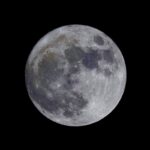The Significance of the Harvest Moon and the Final Supermoon of 2023
Astronomical Marvel and Cultural Traditions
The recent appearance of the harvest moon, coinciding with the final supermoon of 2023, has captivated sky gazers and cultural enthusiasts around the world. This celestial phenomenon, characterized by the moon’s proximity to Earth and its larger, brighter appearance, has both scientific and cultural significance.
The Science Behind the Supermoon
A supermoon occurs when the full moon is in closest proximity to Earth, making it appear larger and brighter than usual. In September, the full moon reached its peak illumination around 5:58 a.m. ET, but it remained visible and fully illuminated through Saturday morning. According to NASA, this supermoon was expected to be about 5% bigger and 13% brighter than an average full moon.
The term “supermoon” is not universally defined, but generally refers to a full moon that is closer to Earth than usual. In this case, the moon was approximately 224,854 miles (361,867 kilometers) away from Earth, about 14,046 miles (22,604 kilometers) closer than its average distance. The closest supermoon of the year occurred on August 30, when the moon was just 221,954 miles (357,200 kilometers) away from Earth.
The Symbolism of the Harvest Moon
The harvest moon is aptly named due to its proximity to the autumnal equinox and the beginning of the fall season. Traditionally, this time of year is when crops peak in the Northern Hemisphere, and farmers rely on the moon’s luminosity to extend their working hours and gather their harvest before the first frost. The Old Farmer’s Almanac notes that the bright harvest moon once aided farmers in their labor, enabling them to work into the evening.
Indigenous tribes have also bestowed various names upon September‘s full moon. For example, the Abenaki tribe refers to it as the “corn maker moon,” the Lakota people as the “moon of the brown leaves,” and the Passamaquoddy tribe as the “autumn moon.” These names honor the significance of the season and its connection to agricultural practices.
Cultural Celebrations and Traditions
The harvest moon is not just a scientific marvel but is also deeply intertwined with cultural celebrations around the world. In Korea, the festival of Chuseok takes place during this time, commemorating the autumn harvest and paying homage to ancestors. Similarly, in Japan, the Buddhist holiday of Higan is observed, which also involves remembering ancestors and expressing gratitude for the harvest.
Furthermore, the harvest moon coincides with the beauty of nature and the changing hues of the sky. Many people associate the moon with an orange glow as it rises, but this phenomenon is true for all full moons. The color is a result of Earth’s atmosphere being thicker near the horizon, creating a greater scattering of light.
Looking Ahead: Upcoming Lunar and Solar Eclipses, Meteor Showers
In addition to the fascinating harvest moon and supermoon, there are several other noteworthy astronomical events to anticipate.
Lunar and Solar Eclipses
On October 14, an annular solar eclipse, also known as the “Ring of Fire,” will occur. This eclipse will be visible in North, Central, and South America. During the event, the moon will pass between the sun and Earth, appearing smaller than the sun and surrounded by a glowing halo. It is essential to wear eclipse glasses to protect one’s eyes when observing this celestial phenomenon.
Furthermore, on October 28, a partial lunar eclipse will take place. This event will be visible in Europe, Asia, Australia, parts of North America, and much of South Africa. During a partial lunar eclipse, only a portion of the moon enters Earth’s shadow, as the sun, Earth, and moon do not align completely.
Meteor Showers for Stargazers
For stargazers and astronomy enthusiasts, several meteor showers are expected to peak later this year. These meteor showers offer an opportunity to witness shooting stars and celestial beauty.
Here are the peak dates for the remaining meteor showers in 2023:
– Draconids: October 8
– Orionids: October 20-21
– Southern Taurids: November 4-5
– Northern Taurids: November 11-12
– Leonids: November 17-18
– Geminids: December 13-14
– Ursids: December 21-22
Meteor showers are best observed in areas without light pollution, during the late evening until dawn.
Editorial: Embracing the Wonders of the Night Sky
These celestial events offer a chance to reflect on the magnificence of the universe and our place within it. In our busy lives, it is easy to overlook the beauty and grandeur of the night sky. However, taking a moment to observe and appreciate these phenomena can be a humbling and awe-inspiring experience.
It is essential to remember that these cosmic events occur on a regular basis, reminding us of the rhythm and cycles of the natural world. The waxing and waning of the moon, as well as the dance of the planets and the meteor showers, offer us an opportunity to reconnect with the vastness of space and the wonders it holds.
Advice: Embrace the Night Sky and its Marvels
To fully engage with the beauty of the night sky and celestial events, here are a few suggestions:
1. Find a suitable observation location: Look for areas away from city lights and light pollution to maximize the visibility of celestial phenomena.
2. Educate yourself: Learn about the various astronomical events, their significance, and the science behind them. Explore different cultures’ traditions and how they celebrate these events.
3. Join astronomy groups or clubs: Connect with like-minded individuals who share an interest in astronomy. Participating in group observations or discussions can enhance your understanding and enjoyment of celestial events.
4. Keep track of upcoming events: Many online resources provide calendars and notifications of upcoming celestial events. Take advantage of these tools to plan and prepare for observations.
5. Stay safe during solar eclipses: Remember to protect your eyes during solar eclipses by using eclipse glasses or other approved viewing materials. Never look directly at the sun without proper protection.
By embracing the wonders of the night sky, we can deepen our appreciation for the natural world and expand our knowledge of the universe. Whether it be witnessing a supermoon, experiencing a solar eclipse, or marveling at a meteor shower, these events serve as reminders of the beauty and mystery that surround us.

<< photo by Johannes Plenio >>
The image is for illustrative purposes only and does not depict the actual situation.
You might want to read !
- Editorial Exploration: Examining the motivations for not watching the highly anticipated cricket match between India and Pakistan in the World Cup.
Title: “An Introspective Journey: My Decision to Abstain from Watching the India-Pakistan Cricket World Cup Clash”
- Unveiling the Untold Story: Sheffield Wednesday vs Sunderland Live Commentary
- The Battle for Championship Survival: Sheffield Wednesday vs Sunderland – Live Match Analysis
- “Embracing the Radiance: Harvest Moon 2023 Illuminates the Gateway to Autumn”
- “Unlocking the Mysteries of the September 2023 Full Moon: Unveiling the Enigma of the ‘Harvest Moon’ Tonight”
- Extreme Climate Extremes: Australia’s Scorching Spring and America’s Chilling Surprise
- Unclaimed €185K EuroMillions Prize: The Hunt for the Mystery Winner Begins
- Mysterious Winner: £185m EuroMillions Lottery Jackpot Remains Unclaimed
- Exploring the Blood-soaked Brilliance of Netflix’s Castlevania: Nocturne Series
- Bangladesh vs New Zealand 3rd ODI Live Score: A Clash of Titans
- Late Drama as Huddersfield Secure Draw Against Coventry




